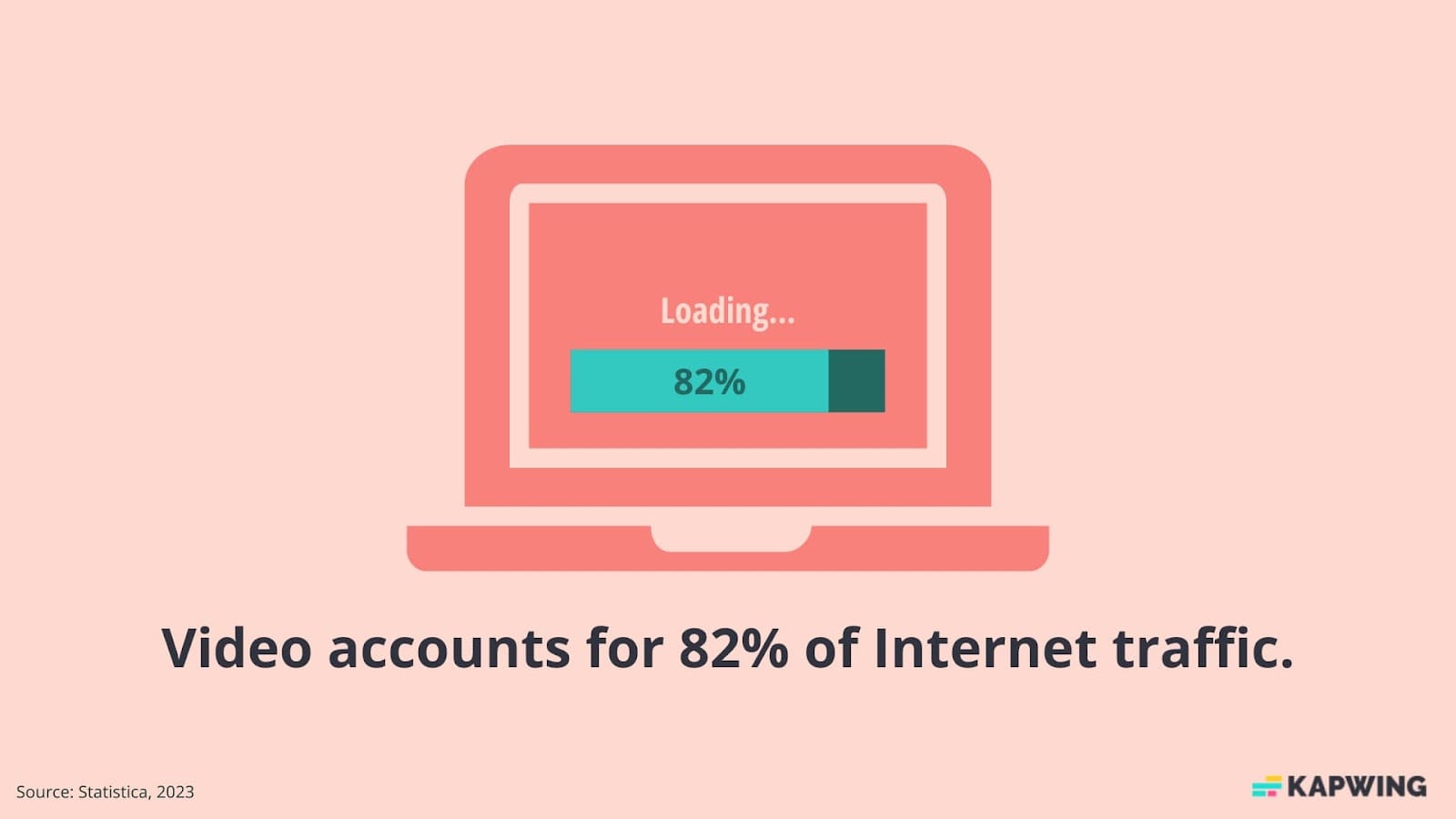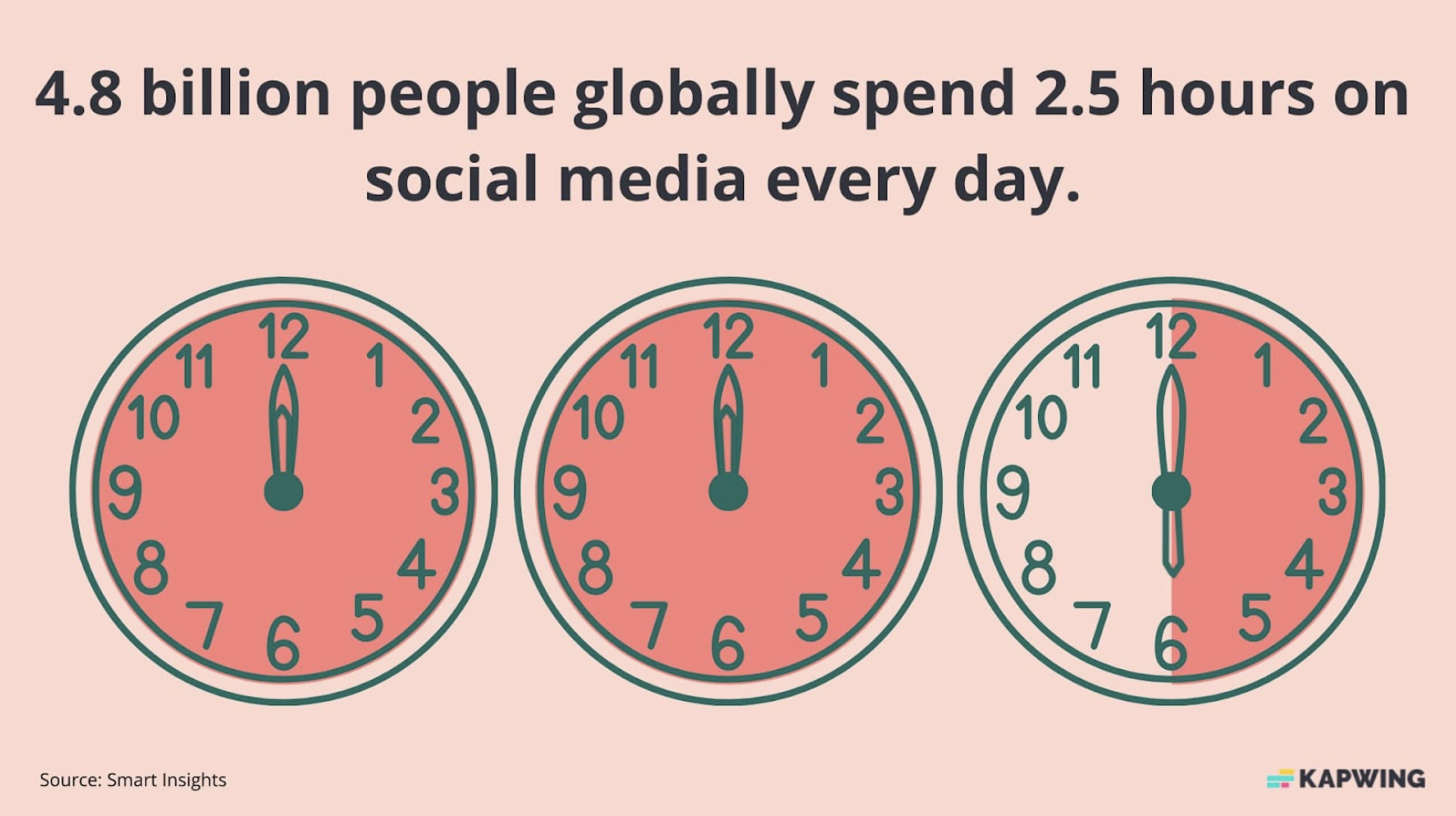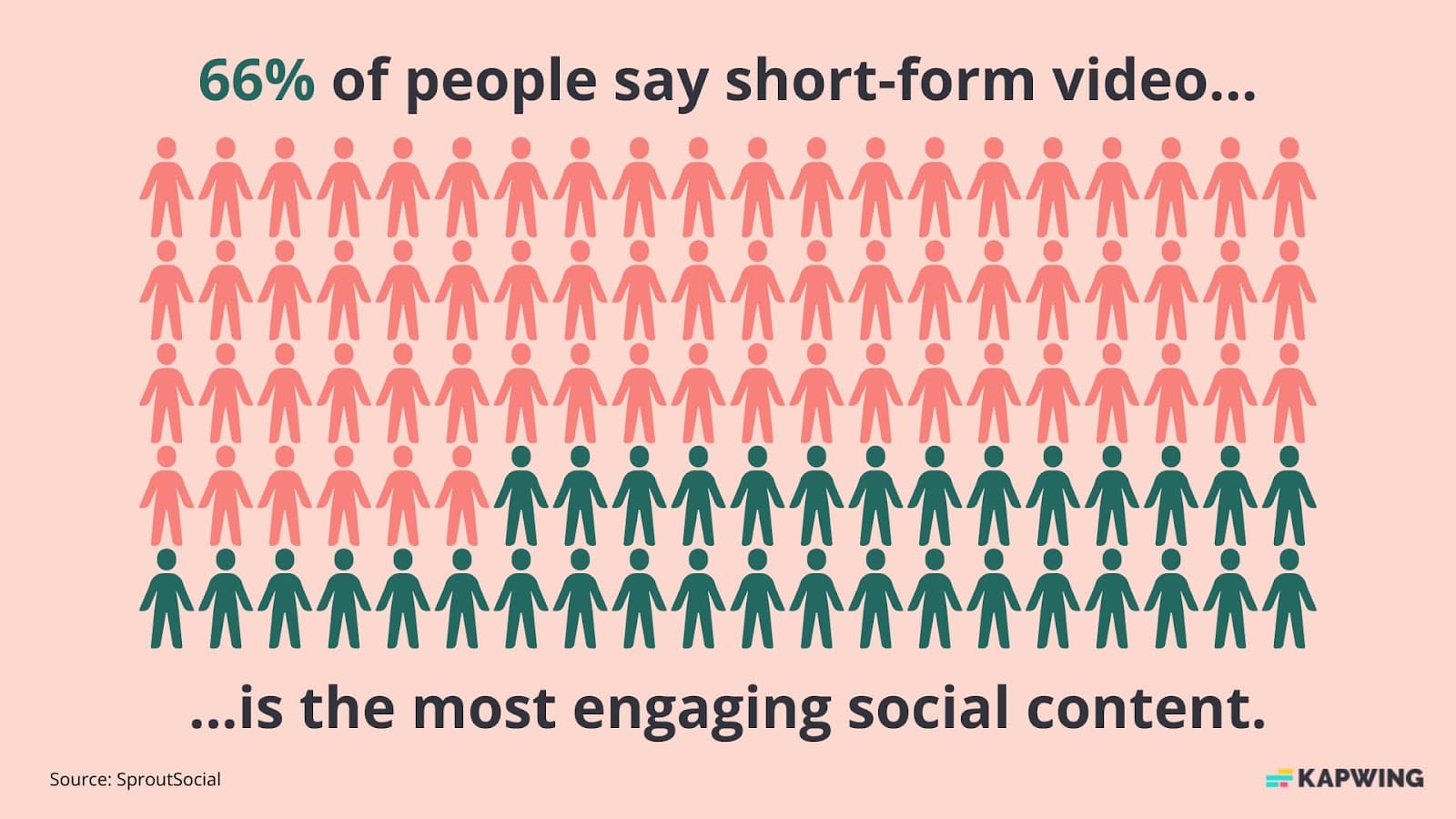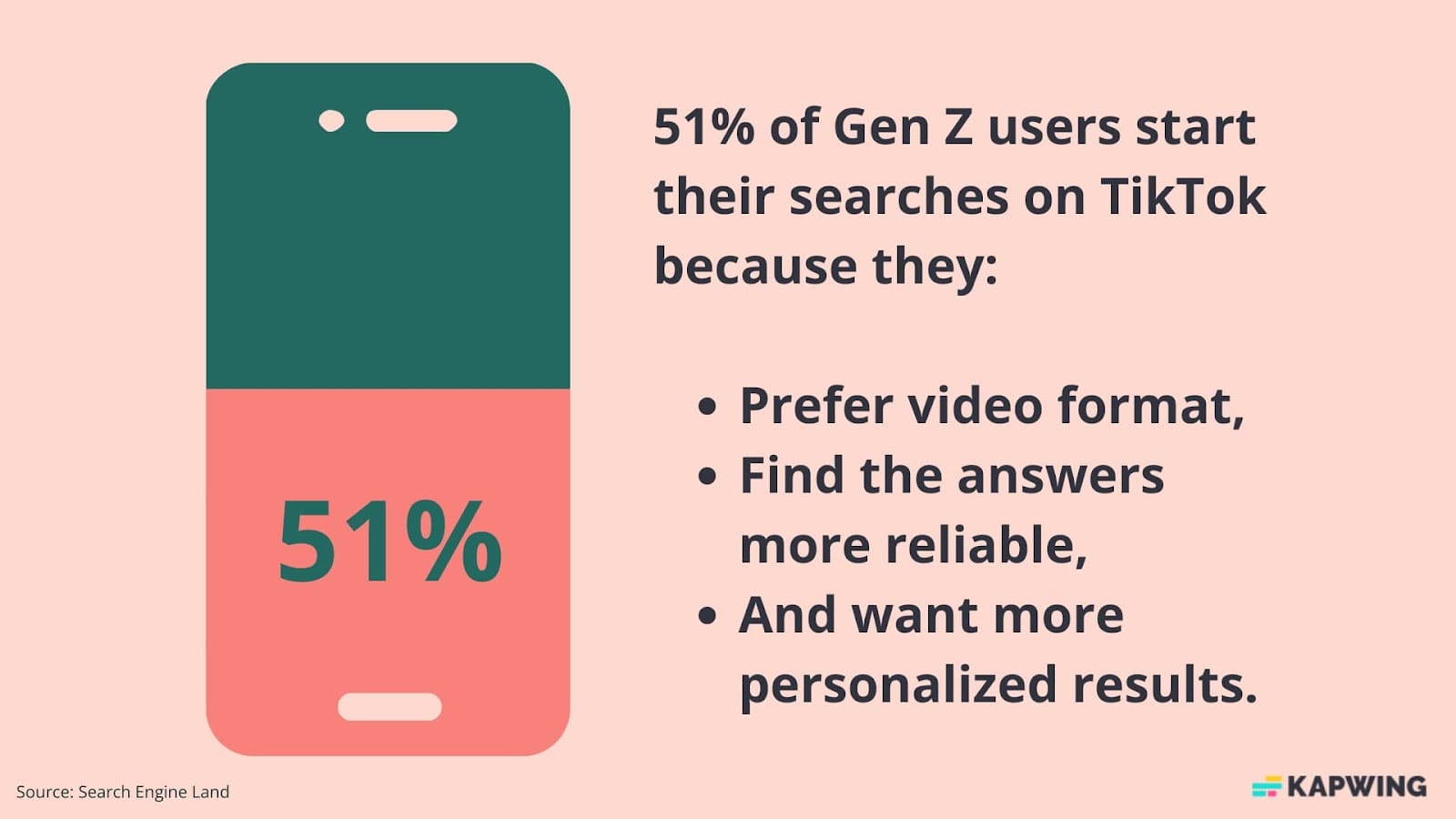4 Reasons Video Continues to Be a Top Marketing Trend
Why is video such a popular marketing "trend" year after year? We unpack the current conditions making video such a powerful marketing channel plus make a prediction for the future of video marketing.

As we near the end of the year, companies are starting to release their trend predictions and reports for 2024—and we already know video is going to top the lists. Video has been a “trend” in marketing for the last ten years.
You don't have to sell the value of video marketing to us here at Kapwing. We’ve been making the case for video as the anchor medium for teams for a while now, and the data supports our case. So, why do marketers keep talking about video as a trend when we’ve all been operating in a decidedly video-first world for the last few years?
In our experience, whenever there are long-running talking points or trends like this, they (mostly) fall into three categories:
- Trends that promise unimaginably exciting potential but are somewhat of a present-day letdown. The potential is so strong, though, that a group of people collectively hold out hope and reignite the discussion every few months.
- Trends that promise a pretty exciting future, but that seem to be a bit of an iceberg—the deeper we go, the more we discover, and eventually we look back to find the surface-level potential that everyone saw as a dramatic underestimation.
- World-changing trends that meet both of those criteria.
Things like VR would fall into the first category; generational technologies, like the internet, fall into the third. And, as you might have guessed, “marketing with video” falls squarely into the second category. That’s why it’s such a sticky “trend.”
Video feels like a forever trend in marketing largely because (a) it’s potential is still promising, (b) its current application and results are undeniable, and (c) the marketing landscape keeps changing in ways that work out in video’s favor.
Let’s unpack some of the conditions currently contributing to video’s popularity as well as future potential for where video might be going.
Tech advancements made video production (and consumption) easier
The demand for video online isn’t new. We’d argue that users always wanted video, but it was only in the last decade that the technology allowed the supply to catch up with the demand.
Everything about creating and publishing quality video has become easier. We don’t mean film-grade quality here. Rather, compare what your phone with some natural light is capable of recording today to any footage from a YouTube video posted in 2011; the difference in quality is stark. Now, anyone can create a high-res video with clear audio and post it almost anywhere.
Not only has the gear gotten better, the editing process has gotten easier, too. Video editing software has become both more powerful and more user-friendly. You don’t need a degree in video production and a heavy desktop editor with an incredibly steep learning curve to make great video anymore. Online video editors are keeping pace with the traditional editors–and even outpacing them in some areas.
And the demand for video has grown accordingly.

Video is heavily favored by users and, as a result, drives more engagement and better ROI than nearly every other content format. Prospects and customers directly ask for more video content in outsized numbers.
Once the supply of good video became unblocked, the demand for video became obvious.
Platform shifts helped make video king
You can’t talk about the rise of video without talking about social media.
One obvious point that still needs to be reinforced is that few knew just how big social platforms would get in 2010. Lots of people saw the opportunity for them to get big, but 4.8 billion people around the world using social media for an average of nearly 2.5 hours daily would have been a wild prediction to make back then.

That was the first tailwind in video’s sails.
The second was directly caused by the platforms themselves: every social network now indiscriminately punishes the performance of offsite links and rewards native, onsite content. That could have theoretically rewarded any type of content, but algorithmic “feeds” became the prominent design for distributing social media posts. These feeds reward quick, get-to-the-point content that users seek out when they don’t know what they’re looking for.
That meant short-form video.
And the available data makes it clear that marketers took notice of this preference. Short-form video is cheaper (generally) to produce, is less time-consuming to produce (if you’ve got a solid repurposing strategy), catches attention in-feed with visuals, and requires the absolute least amount of effort from the user.

Add the fuel of algorithms that encourage people to scroll on for “just one more video/post” and you can trace an important line back to where we are today – short-form video dominates on social media.
Traditional digital marketing channels are increasingly crowded
Another factor speeding video’s rise: tried-and-true B2B marketing strategies and channels started to become prohibitively expensive and competitive. We recently interviewed John Collins, former marketing leader at Intercom and Ramp, about a report he co-produced with the OGM agency on just this topic.
Previously, it was easy for B2B brands to justify not investing in YouTube (even though creators were amassing staggeringly large audiences) because a combination of text content, SEO, and paid distribution was still working. You could run an SEO strategy that was just a keyword list stack ranked based on traffic potential and it would work like a charm.
Try that today and you’ll be left in the dust.
And it wasn’t just organic search that took a hit. Across all traditional marketing channels, we began to see major shifts that fundamentally changed how we had to do business. Email faced spam-ageddon, paid channels priced out many under-funded companies, and social, as we noted earlier, began directly punishing offsite links.
Video, and especially organic, platform-native video content, was there to catch the exodus as marketers searched for new channels. Better still, video became even more economical because you could repurpose clips and segments across nearly every platform and do well.
The final gust supporting this trend was the recent shift in behavior we've seen in younger internet users.

Many now skip Google search in favor of searching video platforms directly, because they distrust traditional search or simply know that platforms like TikTok will surface a reasonably satisfying video.
What’s next: AI’s influence on video creation
All of the above has gotten video marketing to where it is today, but will the good times continue to roll?
First, what we’ve covered here is definitely not in the rear view mirror. It's unlikely the previous three points will become irrelevant in the near future, even if their importance in video’s growth diminishes a little.
The most world-shifting development on the horizon, AI, seems poised to be another windfall for video creators and marketers, especially in the short-term (which is the only timeline we can predict anyway!).
Here's why:
1. AI has and will continue to simplify video creation
Video is seen as the hardest form of content to create. And at a certain level of fidelity, it is. But we’ve seen that if the content is great, the quality can simply be good—and that’s enough for most viewers.
AI-powered platforms like Kapwing already save hours of time for tedious editing tasks to help you create good (and great!) video content. In the near future, generative video will reach a threshold where brands see the output as good enough to publish without much or any human editing.
2. People will want transparency around authorship and AI usage
We believe the growth in AI-generated content will be mostly embraced, but there’s evidence to suggest that people will want to know what is AI-generated and will place even greater emphasis on learning from verified, experienced individuals for certain topics.
Platforms like YouTube and Google are already setting measures in place to ensure transparency around AI-generated content and promote human-authored results.
Video is a shortcut to this more personal form of authority. Viewers feel like they know the person in front of the camera better than the person (or bot?) in front of the keyboard that they can’t see or verify. Many brands are leaning into this by leveraging in-house and third-party subject matter experts to create more authentic thought leadership content.
For a deeper dive into why video persists as a marketing trend, check out the episode of our podcast where we discuss the topic further.









